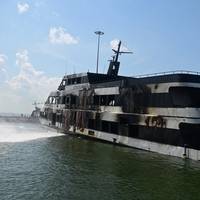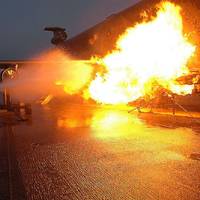NTSB Urges USCG to Remove Subchapter K Exemptions for Fire Safety

The National Transportation Safety Board (NTSB) recommended Tuesday that engine-room fire detection and fixed fire extinguishing systems be installed in small passenger vessels previously exempted from U.S. Coast Guard regulations in Subchapter K.The NTSB issued the recommendations after investigating an engine room fire aboard the Spirit of Norfolk during a sightseeing cruise near Naval Station Norfolk, Viriginia, on June 7, 2022, with 108 people on board. The fire was too large for the crew to fight, and the passengers and crew were evacuated to other vessels.
IMO implements new SOLAS fire protection requirements for on-deck cargo areas

The International Maritime Organization (IMO) has introduced new requirements for the fire protection of on-deck cargo areas. The new requirements, which will be added to SOLAS regulation II-2/10, apply to all ships designed to carry containers that are constructed on or after January 1, 2016. The new regulations stipulate that new ships designed to carry containers on or above the weather deck shall be fitted with at least one water mist lance, and that ships designed to carry five or more tiers of containers on or above the weather deck must be fitted with mobile water monitors.
USCG Marine Safety Alert 05-12

Pressure Switch Location for Fixed Fire Suppression Systems Where's yours located? This safety alert addresses the location of fire suppression system pressure switches aboard vessels. These critical components sense the activation of the system and then electrically secures the ventilation systems operating in the protected space. Securing the ventilation is essential in extinguishing a fire onboard a vessel. It assists in isolating the fire within the space, minimizes the introduction of additional oxygen to fuel the fire and prevents the loss of fire suppression agents from the space.
Ferry Fire Linked to Poor Inspection and Maintenance
The National Transportation Safety Board determined that the probable cause of a fire aboard a New York City commuter ferry was the operator’s inadequate inspection and maintenance of the vessel’s electrical system. Contributing to the extent of the damage were the absence of fixed fire detection and suppression systems and the crew’s lack of knowledge of proper marine firefighting techniques. The fire occurred on the evening of November 17, 2000, as the commuter ferry Port Imperial Manhattan, with three crewmembers and eight passengers aboard, was en route from Manhattan to Weehawken, NJ. Beginning in the engine room, the fire soon burned out of control, causing the vessel to lose power and forcing passengers and crew to abandon the interior spaces.
NTSB Reports on Ferry Fire
The National Transportation Safety Board determined that the probable cause of a fire aboard a New York City commuter ferry was the operator's inadequate inspection and maintenance of the vessel's electrical system. Contributing to the extent of the damage were the absence of fixed fire detection and suppression systems and the crew's lack of knowledge of proper marine firefighting techniques. The fire occurred on the evening of November 17, 2000, as the commuter ferry Port Imperial Manhattan, with three crewmembers and eight passengers aboard, was en route from Manhattan to Weehawken, NJ. Beginning in the engine room, the fire soon burned out of control, causing the vessel to lose power and forcing passengers and crew to abandon the interior spaces.
USCG to Require Anchors, Emergency Retrieval Systems
The USCG has issued an interim rule requiring anchors and emergency retrieval systems on tank barges and the vessels towing them in coastal and Great Lakes service. In a significant change from the October 1997 notice of proposed rulemaking (NPRM), the rule requires all single-hulled tank barges operating on the U.S. territorial sea, the Great Lakes, Long Island Sound, Strait of Juan de Fuca, and parts of Puget Sound, be equipped with an operable anchor system. In addition, both single- and double-hulled tank barges and the vessels towing them must be equipped with an emergency retrieval system, such as an emergency towline or an Orville Hook. The rule also requires equipment be maintained and inspected regularly, and crewmembers be trained and drilled in its use.
USCG Issues Fire Protection Equipment Requirements
All towing vessels except those in restricted services are required to comply with new requirements for fire protection equipment and procedures under an interim rule issued by the USCG. The rule is the first step in a two-pronged approach to implementing the requirements of the 1996 USCG Authorization Act, which directed the USCG to promulgate regulations requiring fire suppression systems or other measures to control fires on towing vessels. · An engine room fire detection system with visible and audible alarms. · A fixed or portable system allowing for two-way communication between the pilothouse and the engine room. · A remote fuel shutoff for the main engine and other fuel lines.
Fire Protection Rules Require Further Changes
The USCG's interim rule on fire protection equipment for towing vessels requires modification to avoid unnecessary and costly burdens on owners of existing towing vessels, AWO told the USCG. Reiterating its support for the basic suite of equipment and procedural requirements contained in the interim rule ? a general alarm, fire detection system, internal communications system, remote fuel shutoff, and training and drill procedures for crewmembers ? AWO urged the USCG to modify the technical specifications for fire detection systems and fuel shutoff valves before the October 2001 deadline for installation of such equipment. The interim rule requires a fire detection system be used for no other purpose…









